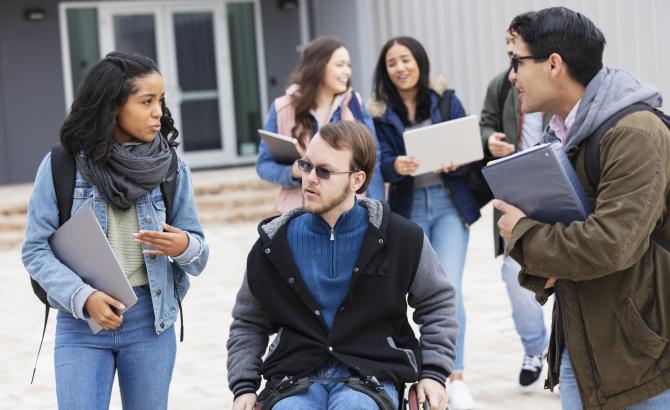2022 First-Year Law School Class: A Focus on Students with Disabilities
Disproportionate burdens are placed on students with disabilities[1], in life and in law school, as compared to students without disabilities — whether it’s the often costly and time-consuming process of having to prove one’s disability, difficulties obtaining accommodations, confronting stigmas around the receipt of accommodations, or other aspects of living and learning in a largely non-accessible world.[2] These processes can be isolating and affect students’ sense of belonging. It can be particularly difficult when students have “non-apparent” disabilities — such as mental health disorders, chronic pain, autoimmune disorders, and other types of disabilities — which can result in feeling extra pressure to “perform” one’s disability in order to be believed. The multiple identities of law students with disabilities (i.e., the intersectionality of identities) can exacerbate existing inequities; for example, socioeconomic barriers for students with disabilities are compounded for racially and ethnically minoritized[3] students with disabilities.[4]
To date, there is limited data about how many students with disabilities enroll in law school each year. In October 2022, LSAC distributed a survey to all 2022 law school matriculants to understand who current law school matriculants are and what factors they considered to determine which law school(s) would meet their academic, professional, and personal needs. For the first time, LSAC included questions on disability[5] to begin understanding how the law school application and decision-making processes are experienced by individuals with disabilities.
The purpose of this report is to provide nuanced information about factors that affect law school decision-making processes for students with disabilities. These factors include personal considerations, such as whether to disclose a disability to law schools, as well as school-choice factors including 1) faculty and academic support, 2) diversity-related factors, 3) health services and financial factors, and 4) law school recruitment activities. The report also provides extensive recommendations that schools can use to 1) assess their own practices and policies that impact students with disabilities and 2) think about ways to remove barriers for students with disabilities from the application stage all the way to graduation.
Key insights from the report include:
- In 2022, 12% of students in their first year of law school (2022 law school matriculants) identified as a person with a disability.
- Students reporting a disability were more likely to be white, continuing-generation college, cisgender, and straight (i.e., heterosexual) students.
- Over 40% of law students with a disability did not disclose their disability on their law school applications. Those identifying as men were more likely to disclose their disability than were women or gender diverse students[6] (54%, 43%, and 42%, respectively).
- Students with disabilities entered law school with higher average undergraduate education debt loads than students without disabilities.
- When choosing their law school, students with disabilities generally assigned more importance to a school’s commitment to diversity, equity, and inclusion (DEI) — including having faculty from marginalized communities and course offerings that address these communities — than did students without disabilities.
- Law students with disabilities reported assigning more significance to the availability of student supports, including academic support services, disability services, mental health services, DEI programming and services, and the availability of healthcare coverage, than did students without disabilities.
- Compared to college or university students without disabilities, students with disabilities more often rated as “important” or “very important” recruitment activities including 1) open houses where applicants could attend classes and meet with law students and faculty and 2) prelaw fairs on the college or university campus where students could meet with representatives from the law school.
To learn more about how students with disabilities experience the journey to law school, as well as important aspects in their decision-making process, please download the full report.
If you have any questions related to this project or future work informed by the results, please contact LSAC DEI and Strategic Research at DiversityOffice@LSAC.org or StrategicResearch@LSAC.org.
[1] LSAC has chosen to use Person-First language in alignment with the National Organization on Disability, the American Association of People with Disabilities, and the American Bar Association. Person-First language is largely recognized as emphasizing the individual over their disability, condition, or diagnosis. We respect and honor an individual’s personal preferences when referring to their own disability, including the use of Identity-First language.
[2] Emens, E. F. (2020). Disability admin: the invisible costs of being disabled. Minn. L. Rev., 105, 2329.
[3] The use of “minoritized” is intended to refer to the “process [action vs. noun] of student minoritization” that reflects an understanding of “minority” status as that which is socially constructed in specific societal contexts. Benitez, Jr., M. (2010). Resituating culture centers within a social justice framework: Is there room for examining whiteness? In L. D. Patton (Ed.), Culture centers in higher education: Perspectives on identity, theory, and practice (pp. 119-134). Stylus Publishing. Stewart, D. L. (2013). Racially minoritized students at U.S. four-year institutions. The Journal of Negro Education, 82(2), 184-197. For example, women are not minorities in legal education today, but they are one of many minoritized groups. These are groups that face social, political, economic, and educational barriers that constrict them. Minoritized groups include women, students of color, first-generation college students, students with disabilities, students of low socioeconomic status, and LGBTQIA+, transgender, and gender-nonconforming students, to name a few.
[4] Payne-Tsoupros, C. (2020). A starting point for disability justice in legal education. Journal Committed to Social Change on Race and Ethnicity (JCSCORE), 6(1), 165-189.
[5] These questions were developed with the input of a focus group of current and former law students with disabilities organized by the Coelho Center for Disability Law, Policy, and Innovation as well as the ABA Council on Disability Rights.
[6] The category “gender diverse” includes anyone who identified as transgender, gender nonbinary, or another gender identity (with the option to specify). Due to the small number of individuals identifying as each, those who identified as anything other than man or woman were considered as one group for comparison purposes.



